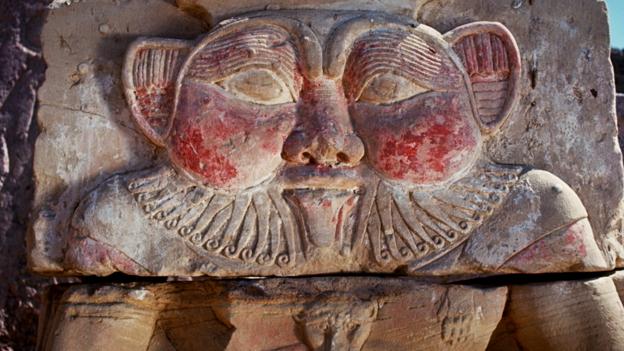
Earlier this year I visited the temple of the goddess Hathor at Dendera on the west bank of the Nile in Egypt. Dating from perhaps the first century BC, the temple is decorated with a relief depicting Cleopatra, paramour of Julius Caesar and Mark Antony, and Egypt’s final pharaoh. Few images of Cleopatra survive – a haggish profile stamped on a bronze coin suggests that she looked nothing like Elizabeth Taylor in Joseph L Mankiewicz’s epic film of 1963 – so the relief at Dendera is tantalising and important.
Yet my eye was drawn to another figure altogether who was considerably more ugly than pointy-chinned Cleopatra. This frightening character appears in several places around the site, but he is especially prominent in a relief carved onto a fragmentary limestone pillar that once supported a smaller building known as the ‘birth house’ near the temple.
With the squat, stocky body of a bandy-legged dwarf, he faces outwards, arms akimbo. His grotesque head has a leering, lewd expression, as his thick tongue lolls towards his chin, while the strands of his beard end in flickering spirals. A tail dangles suggestively between his legs. This, I learned, was the ancient Egyptian deity Bes – who was beloved for centuries not only in Egypt but also across the Mediterranean, and ultimately helped to shape the appearance of the Christian Devil.
Although he never had a state-sanctioned cult, Bes was tremendously popular in ancient Egypt. He was worshipped in ordinary homes, where he was associated with many of the good things in life: sex, drinking, music, and merriment. He also had an important protective function, and was often invoked during childbirth (hence his appearance in the divine birth house at Dendera). In other words, although to modern eyes he may appear frightening, he was actually decent. Friend to beer-swilling carousers and expectant mothers alike, he warded off noxious spirits like a gargoyle on a medieval church.
Wine, women and song
According to the Iranian archaeologist Kamyar Abdi, “The Bes-image was used in ancient Egypt to decorate a large number of personal belongings and furniture. [He] was carved on beds or headrests, mirrors and spoon handles, amulets, and cosmetic containers.” As a result, museums around the world contain thousands of artefacts (including ‘magical’ wands and knives) adorned with the hypnotically repulsive face of Bes, who often wears a distinctive plumed headdress, and shakes a rattle. The Egyptian Museum in Berlin, for instance, contains a colourful vase decorated with his mask-like features and mane-like hair.
The origins of Bes remain obscure. Perhaps he is a composite of up to 10 separate deities. From an art historical point of view, he is certainly a curiosity: unlike most Egyptian gods, who usually appear in profile, Bes is brazen and frontal, as well as comical. Some scholars suggest that he emerged in sub-Saharan Africa. It is possible that he began life as a lion or cat rearing on its hind paws.
Ultimately Bes was celebrated because he was never official or exclusive. Mischievous and irreverent (it was said that he could make babies laugh by pulling funny faces), he was resolutely down-to-earth – a god for commoners rather than royalty. Performers tattooed their bodies with images of Bes because of his associations with music and dancing, while prostitutes may have placed tattoos of Bes near their genitalia, in order to stave off sexually transmitted diseases.
By the end of the second millennium BC, Bes had proliferated across the Mediterranean world. Even local, non-Egyptian craftsmen produced objects decorated with his image. Early in the first millennium, the Phoenicians became big fans of Bes, as the Romans would too. Bes occasionally appears dressed as a Roman legionnaire. His rampant popularity even survived the advent of Christianity.
No comments:
Post a Comment